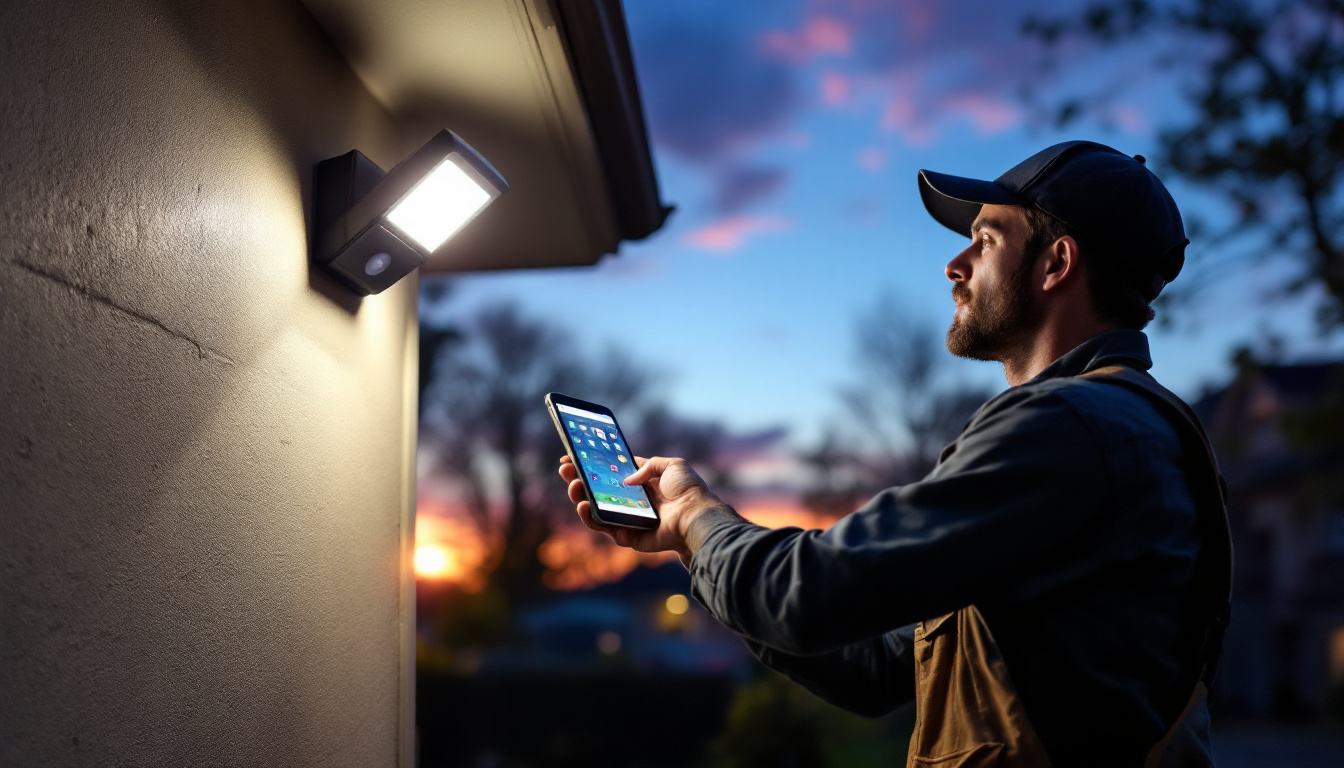

Outdoor motion sensor lights have become an essential component in modern lighting solutions, particularly for contractors specializing in outdoor installations. These innovative devices not only enhance security but also offer significant energy savings and convenience. For lighting contractors, understanding the benefits and applications of motion sensor lights can lead to improved efficiency and customer satisfaction.
As the demand for energy-efficient solutions grows, the integration of motion sensor technology into outdoor lighting systems is increasingly relevant. This article explores how outdoor motion sensor lights can streamline operations for lighting contractors, making their work more efficient and effective.
One of the key advantages of outdoor motion sensor lights is their ability to automatically illuminate areas only when needed. This feature not only deters potential intruders but also minimizes energy consumption, as the lights remain off during periods of inactivity. Furthermore, many modern motion sensor lights come equipped with adjustable sensitivity settings and timers, allowing contractors to customize the lighting experience based on the specific needs of their clients. This level of customization can significantly enhance the appeal of a contractor’s service offerings, as homeowners increasingly seek tailored solutions that fit their unique lifestyles.
In addition to their practical benefits, outdoor motion sensor lights contribute to a more sustainable environment. By reducing unnecessary energy use, these lights help lower carbon footprints and promote eco-friendly practices. Many manufacturers are now producing solar-powered motion sensor lights, which harness renewable energy and further reduce electricity costs. This trend aligns perfectly with the growing consumer preference for green technology, making it a valuable selling point for contractors. As they educate clients on the advantages of these systems, contractors can position themselves as forward-thinking professionals who prioritize both security and sustainability in their outdoor lighting designs.
Motion sensors operate by detecting movement within a specified range. They typically use passive infrared (PIR) technology, which senses changes in heat emitted by objects, or microwave sensors, which emit microwave pulses and measure their reflection. When a person or object moves within the sensor’s range, the light is activated, providing illumination only when needed.
This technology not only enhances security by illuminating dark areas but also conserves energy by ensuring lights are only on when necessary. For contractors, this means less time spent on manual controls and more efficient use of resources.
There are several types of motion sensors available, each suited for different applications. The most common types include:
Understanding the different types of motion sensors allows contractors to select the most appropriate technology for their specific projects, enhancing efficiency and effectiveness.
One of the most significant advantages of outdoor motion sensor lights is their energy efficiency. By automatically turning on only when motion is detected, these lights reduce unnecessary energy consumption. This not only lowers electricity bills for clients but also contributes to a more sustainable approach to outdoor lighting.
For lighting contractors, this translates into a compelling selling point. Clients are increasingly interested in energy-efficient solutions, and the installation of motion sensor lights can significantly enhance the overall value of a project. Additionally, contractors can benefit from reduced operational costs, as less energy consumption often leads to lower maintenance expenses over time.
Outdoor motion sensor lights play a crucial role in enhancing security for residential and commercial properties. By illuminating areas when motion is detected, these lights deter potential intruders and provide safety for occupants. This added layer of security is a strong selling point for contractors, as clients are often willing to invest in solutions that protect their homes and businesses.
Moreover, the presence of motion sensor lights can create a sense of safety in outdoor spaces, encouraging clients to utilize their patios, gardens, and walkways more frequently. This increased usage can lead to a more positive perception of the property’s value and functionality.
For lighting contractors, the installation of outdoor motion sensor lights is generally straightforward. Most models come with user-friendly instructions and can be mounted on various surfaces, making them suitable for a wide range of applications. This ease of installation allows contractors to complete projects more quickly, improving overall efficiency.
Additionally, motion sensor lights often require less maintenance compared to traditional lighting solutions. With fewer instances of bulbs burning out due to reduced usage, contractors can spend less time on upkeep and more on new projects. This efficiency can lead to increased profitability and client satisfaction.
In residential settings, outdoor motion sensor lights are commonly used for pathways, driveways, and entryways. These areas benefit greatly from illumination that activates upon approach, providing safety and convenience for homeowners. For contractors, offering motion sensor lights as part of a residential lighting package can enhance the appeal of their services.
Furthermore, homeowners appreciate the ability to customize settings, such as sensitivity and duration of light activation. This flexibility allows contractors to tailor installations to meet the specific needs of each client, further solidifying their reputation for quality service.
In commercial settings, outdoor motion sensor lights are invaluable for enhancing security and visibility. Businesses often have large outdoor areas that require effective lighting solutions to ensure the safety of employees and customers. Motion sensor lights can be strategically placed around perimeters, parking lots, and entrances to provide adequate illumination when needed.
Contractors can leverage the benefits of motion sensor technology to offer comprehensive lighting solutions that address the unique challenges faced by commercial clients. This not only improves the safety of the premises but also enhances the overall aesthetic appeal of the property.
Outdoor motion sensor lights are increasingly being utilized in public spaces such as parks, sidewalks, and recreational areas. These installations contribute to the safety and accessibility of community spaces, encouraging more people to engage with their surroundings after dark. For contractors, this presents an opportunity to work on larger-scale projects that can have a significant impact on community well-being.
Moreover, municipal installations often require adherence to specific regulations and standards. Understanding these requirements can position contractors as knowledgeable experts in the field, enhancing their credibility and attracting more clients.
While outdoor motion sensor lights offer numerous benefits, contractors must also consider environmental factors that can impact their effectiveness. Weather conditions, such as heavy rain, snow, or extreme temperatures, can affect sensor performance and the longevity of the lighting fixtures.
Choosing high-quality, weather-resistant products is essential to ensure that installations remain functional and reliable over time. Contractors should also educate clients about the importance of regular maintenance and potential limitations of motion sensor technology in adverse conditions.
Educating clients about the capabilities and limitations of outdoor motion sensor lights is crucial for managing expectations. Some clients may expect the lights to activate in every situation, while others may not understand how to adjust settings for optimal performance. Providing clear information and guidance can help mitigate misunderstandings and ensure client satisfaction.
Contractors can offer demonstrations during the installation process, showcasing how the sensors work and how clients can customize their settings. This proactive approach not only enhances the client experience but also positions the contractor as a knowledgeable resource.
As smart home technology continues to evolve, many clients are interested in integrating outdoor motion sensor lights with their existing systems. This can enhance convenience and control, allowing homeowners to manage their outdoor lighting remotely. For contractors, staying informed about the latest smart home technologies can open up new opportunities for service offerings.
Understanding compatibility with various smart home platforms can be a valuable asset when advising clients on their lighting options. This knowledge can set contractors apart from competitors and position them as leaders in the industry.
Outdoor motion sensor lights represent a significant advancement in lighting technology, offering numerous benefits for both contractors and clients. As energy efficiency and security remain top priorities for homeowners and businesses alike, the demand for these innovative solutions is likely to grow.
For lighting contractors, embracing this technology can lead to improved efficiency, increased client satisfaction, and enhanced business opportunities. By understanding the various applications, benefits, and challenges associated with outdoor motion sensor lights, contractors can position themselves as experts in the field, ready to meet the evolving needs of their clients.
In a rapidly changing industry, staying informed about the latest trends and technologies is essential. Outdoor motion sensor lights are not just a trend; they are a practical solution that can significantly enhance the quality and efficiency of outdoor lighting installations. By incorporating these systems into their offerings, contractors can ensure they remain competitive and relevant in the dynamic world of lighting design.
Ready to elevate your lighting installations with the efficiency and innovation of outdoor motion sensor lights? At LumenWholesale, we provide lighting contractors with the highest quality, spec-grade lighting products at unbeatable wholesale prices. Say goodbye to middleman markups and hello to a vast selection of reliable, high-performance lighting that meets the most rigorous industry standards. Plus, with free shipping on bulk orders, you can stock up on premium lighting solutions without any hidden fees. Enhance your service offerings and delight your clients with the perfect blend of quality, affordability, and convenience. Discover the best value in wholesale lighting by visiting LumenWholesale today.

Explore the fascinating world of LED UFO lights with our in-depth guide tailored for lighting contractors.

Explore the advantages and drawbacks of installing lighted mailboxes from a lighting contractor’s perspective.

Discover essential insights into track lighting systems with our comprehensive guide tailored for lighting contractors.

Explore how outdoor lighting trends are reshaping the financial landscape for lighting contractors.
Get notified when NEW deals are released.
Optimize your budget with wholesale discounts.
Only top-quality, specification-grade lighting products.
No additional costs at checkout - what you see is what you pay.
We understand the unique needs of contractors.